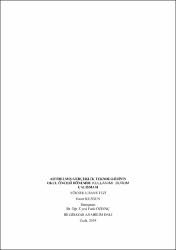| dc.contributor.advisor | Özdinç, Fatih | |
| dc.contributor.author | Kuzgun, Hacer | |
| dc.date.accessioned | 2019-05-14T11:38:32Z | |
| dc.date.available | 2019-05-14T11:38:32Z | |
| dc.date.issued | 2019 | |
| dc.identifier.uri | https://hdl.handle.net/11630/5779 | |
| dc.description | The purpose of the research is to examine the use of the augmented reality technology in early childhood. The research was designed as a case study which is a qualitative research design. A sort of case study is the explanatory case study is conducted to give information about a situation. In the study, a holistic multiple design was used from the case study design. The research group was selected by appropriate sampling method and the criterion sampling method was used for the selection methods. The research group consisted of 18 children and 2 teachers, 9 of whom are boys and 9 are girls, attending the kindergarten of Afyon Kocatepe University in 2017-2018. Children are between 54-77 months. The implementation process lasted 5 weeks. The research data was collected with the semi-structured forms of study, observation, observation note, audio and video records. The data was analyzed with content analysis method.
The results of the study show that the use of augmented reality technology in early childhood, attracts children’s interest and attention, brings the feeling of reality to the children, embodies the content, supports the peer relations positively, provides the information colorful and visual at the same time and provides a fun environment to enable the children to participate in the activities and to focus on the activity. In addition to this, it is seen that augmented reality technology is sometimes a stimulating tool for children to participate in the activity, and sometimes it is a distraction tool that causes the activity to go out of its purpose. In addition, compared to some materials, augmented reality technology has been shown to prefer materials containing network technology in materials that are directly connected to real life, and which do not have a direct connection to real life. At the same time augmented reality technologies, it was concluded that the use in crowded classrooms in early childhood may cause problems in school and time management. At the end of the study, offered suggestions on the use of augmented reality technology in preschool period and future studies. | en_US |
| dc.description.abstract | Bu çalışmanın amacı, artırılmış gerçeklik teknolojisinin okul öncesi dönemde kullanımını incelemektir. Çalışma, nitel bir araştırma modeli olan durum çalışması şeklinde desenlenmiştir. Durum çalışmasının türü, çalışmanın bir durum hakkında bilgi vermek amacıyla yapılmasından ötürü açıklayıcı/tanımlayıcı durum çalışmasıdır. Çalışmada durum çalışması desenlerinden bütüncül çoklu durum deseni kullanılmıştır. Çalışma grubu uygun örnekleme yöntemiyle seçilmiş olup, seçim yöntemlerinden ise ölçüt örnekleme yöntemi kullanılmıştır. Çalışma grubunu 2017- 2018 yılında Afyon Kocatepe Üniversitesi’ne bağlı anaokuluna devam eden 9’u erkek (%50), 9’u kız (%50) 18 çocuk ve 2 öğretmen oluşturmaktadır. Çocuklar 54-77 ay aralığındadır. Uygulama süreci beş hafta sürmüştür. Çalışmada veriler, yarı yapılandırılmış görüşme formları, gözlem, gözlem notu, ses ve video kayıtları yardımıyla toplanmıştır. Veri toplama araçları ile elde edilen veriler, kod ve temalar oluşturularak içerik analizi yöntemi ile analiz edilmiştir.
Çalışmanın sonuçları, artırılmış gerçeklik teknolojisinin okul öncesi dönemde kullanılmasının çocukların ilgi ve dikkatini çektiği, çocuklara gerçeklik hissi yaşattığı, içeriği somutlaştırdığı, akran ilişkilerini olumlu yönde desteklediği, bilgiyi renkli aynı zamanda görsel sunduğu ve eğlenceli bir ortam sağlamasından dolayı çocukların etkinliklere istekli katılmalarını ve etkinliğe odaklanmalarını sağladığını göstermektedir. Bunun yanında artırılmış gerçeklik teknolojisinin, çocukların etkinliğe katılımları konusunda bazen teşvik edici bir araçken bazense etkinliğin amacı dışına çıkmasına neden olan dikkat dağıtan bir araç olduğu görülmüştür. Ayrıca, artırılmış gerçeklik teknolojisi bazı materyallerle kıyaslandığında, çocukların doğrudan gerçek yaşamla bağlantısı bulunan materyalleri tercih ettiği, gerçek yaşamla doğrudan bağlantısı bulunmayan materyallerde ise artırılmış gerçeklik teknolojisi içeren materyalleri tercih ettiği görülmüştür. Aynı zamanda artırılmış gerçeklik teknolojilerinin, okul öncesi dönemde kalabalık sınıflarda kullanılmasının, sınıf ve zaman yönetimi konularında problemler oluşturabileceği sonucuna varılmıştır. Çalışmanın sonunda artırılmış gerçeklik teknolojisinin okul öncesi dönemde kullanımına ve gelecek çalışmalara yönelik öneriler sunulmuştur. | en_US |
| dc.language.iso | tur | en_US |
| dc.rights | info:eu-repo/semantics/openAccess | en_US |
| dc.subject | Okul öncesi, Okul öncesi teknoloji, Artırılmış gerçeklik, Materyal karşılaştırma, Okul öncesi artırılmış gerçeklik. | en_US |
| dc.title | Artırılmış Gerçeklik Teknolojisinin Okul Öncesi Dönemde Kullanımı: Durum Çalışması | en_US |
| dc.title.alternative | Utılızatıon of Augmented Realıty in Early Chıldhood: A Case Study | en_US |
| dc.type | masterThesis | en_US |
| dc.department | Afyon Kocatepe Üniversitesi, Fen Bilimleri Esntitüsü | en_US |
| dc.identifier.startpage | 1 | en_US |
| dc.identifier.endpage | 190 | en_US |
| dc.relation.publicationcategory | Tez | en_US |



















